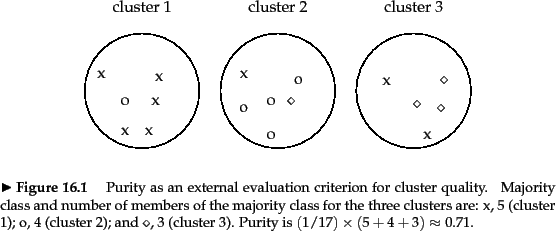互相關資訊和歸一化互相關資訊
實驗室最近用到nmi( Normalized Mutual information )評價聚類效果,在網上找了一下這個演算法的實現,發現滿意的不多.
浙江大學蔡登教授有一個,http://www.zjucadcg.cn/dengcai/Data/code/MutualInfo.m ,他在資料探勘屆地位很高,他實現這個演算法的那篇論文引用率高達三位數。但這個實現,恕個人能力有限,我實在是沒有看懂:變數命名極為個性,看的如墜雲霧;程式碼倒數第二行作者自己添加註釋why complex,我就更不懂了;最要命的是使用他的函式MutualInfo(L1,L2)得到的結果不等於MutualInfo(L2,L1),沒有對稱性!
還有個python的版本http://blog.sun.tc/2010/10/mutual-informationmi-and-normalized-mutual-informationnmi-for-numpy.html,這個感覺很靠譜,作者對nmi的理解和我是一樣的。
我的理解來自wiki和stanford,其實很簡單,先說一下問題:例如stanford中介紹的一個例子:

比如標準結果是圖中的叉叉點點圈圈,我的聚類結果是圖中標註的三個圈。
或者我的結果: A = [1 1 1 1 1 1 2 2 2 2 2 2 3 3 3 3 3];
標準的結果 : B = [1 2 1 1 1 1 1 2 2 2 2 3 1 1 3 3 3];
問題:衡量我的結果和標準結果有多大的區別,若我的結果和他的差不多,結果應該為1,若我做出來的結果很差,結果應趨近於0。
MI可以按照下面的公式計算。X=unique(A)=[1 2 3],Y=unique(B)=[1 2 3];

分子p(x,y)為x和y的聯合分佈概率,
p(1,1)=5/17,p(1,2)=1/17,p(1,3)=0;
p(2,1)=1/17,p(2,2)=4/17,p(2,3)=1/17;
p(3,1)=2/17,p(3,2)=0,p(3,3)=3/17;
分母p(x)為x的概率函式,p(y)為y的概率函式,x和y分別來自於A和B中的分佈,所以即使x=y時,p(x)和p(y)也可能是不一樣的。
對p(x): p(1)=6/17p(2)=6/17p(3)=5/17
對p(y): p(1)=8/17p(2)=5/17P(3)=4/17
這樣就可以算出MI值了。
標準化互聚類資訊也很簡單,有幾個不同的版本,大體思想都是相同的,都是用熵做分母將MI值調整到0與1之間。一個比較多見的實現是下面所示:
![]()
H(X)和H(Y)分別為X和Y的熵,下面的公式中log的底b=2。
![]()
例如H(X) = -p(1)*log2(p(1)) - -p(2)*log2(p(2)) -p(3)*log2(p(3))。
matlab實現程式碼如下
 function MIhat = nmi( A, B )
function MIhat = nmi( A, B )
%NMI Normalized mutual information
% http://en.wikipedia.org/wiki/Mutual_information
% http://nlp.stanford.edu/IR-book/html/htmledition/evaluation-of-clustering-1.html
% Author: http://www.cnblogs.com/ziqiao/ [2011/12/13]
if length( A ) ~= length( B)
error('length( A ) must == length( B)');end
total = length(A);
A_ids = unique(A);
B_ids = unique(B);
% Mutual information
MI = 0;
for idA = A_ids
for idB = B_ids
idAOccur = find( A == idA );
idBOccur = find( B == idB );
idABOccur = intersect(idAOccur,idBOccur);
px = length(idAOccur)/total;
py = length(idBOccur)/total;
pxy = length(idABOccur)/total;
MI = MI + pxy*log2(pxy/(px*py)+eps); % eps : the smallest positive number
end
end
% Normalized Mutual information
Hx = 0; % Entropies
for idA = A_ids
idAOccurCount = length( find( A == idA ) );
Hx = Hx - (idAOccurCount/total) * log2(idAOccurCount/total + eps);
end
Hy = 0; % Entropies
for idB = B_ids
idBOccurCount = length( find( B == idB ) );
Hy = Hy - (idBOccurCount/total) * log2(idBOccurCount/total + eps);
end
MIhat = 2 * MI / (Hx+Hy);
end
% Example :
% (http://nlp.stanford.edu/IR-book/html/htmledition/evaluation-of-clustering-1.html)
% A = [1 1 1 1 1 1 2 2 2 2 2 2 3 3 3 3 3];
% B = [1 2 1 1 1 1 1 2 2 2 2 3 1 1 3 3 3];
% nmi(A,B)
% ans = 0.3646

為了節省執行時間,將for迴圈用矩陣運算代替,1百萬的資料量執行 1.795723second,上面的方法執行3.491053 second;
但是這種方法太佔記憶體空間, 五百萬時,利用matlab2011版本的記憶體設定就顯示Out of memory了。
 function MIhat = nmi( A, B )
function MIhat = nmi( A, B )%NMI Normalized mutual information
% http://en.wikipedia.org/wiki/Mutual_information
% http://nlp.stanford.edu/IR-book/html/htmledition/evaluation-of-clustering-1.html
% Author: http://www.cnblogs.com/ziqiao/ [2011/12/15]
if length( A ) ~= length( B)
error('length( A ) must == length( B)');end
total = length(A);
A_ids = unique(A);
A_class = length(A_ids);
B_ids = unique(B);
B_class = length(B_ids);
% Mutual information
idAOccur = double (repmat( A, A_class, 1) == repmat( A_ids', 1, total ));idBOccur = double (repmat( B, B_class, 1) == repmat( B_ids', 1, total ));idABOccur = idAOccur * idBOccur';Px = sum(idAOccur') / total;Py = sum(idBOccur') / total;Pxy = idABOccur / total;
MImatrix = Pxy .* log2(Pxy ./(Px' * Py)+eps);MI = sum(MImatrix(:))
% Entropies
Hx = -sum(Px .* log2(Px + eps),2);
Hy = -sum(Py .* log2(Py + eps),2);
%Normalized Mutual information
MIhat = 2 * MI / (Hx+Hy);
% MIhat = MI / sqrt(Hx*Hy); another version of NMI
end
% Example :
% (http://nlp.stanford.edu/IR-book/html/htmledition/evaluation-of-clustering-1.html)
% A = [1 1 1 1 1 1 2 2 2 2 2 2 3 3 3 3 3];
% B = [1 2 1 1 1 1 1 2 2 2 2 3 1 1 3 3 3];
% nmi(A,B)
% ans = 0.3646

參考: stanford的講解:http://nlp.stanford.edu/IR-book/html/htmledition/evaluation-of-clustering-1.html
wiki百科的講解:http://en.wikipedia.org/wiki/Mutual_information
某作者的python的實現:http://blog.sun.tc/2010/10/mutual-informationmi-and-normalized-mutual-informationnmi-for-numpy.html
蔡登的matlab實現:http://www.zjucadcg.cn/dengcai/Data/code/MutualInfo.m
